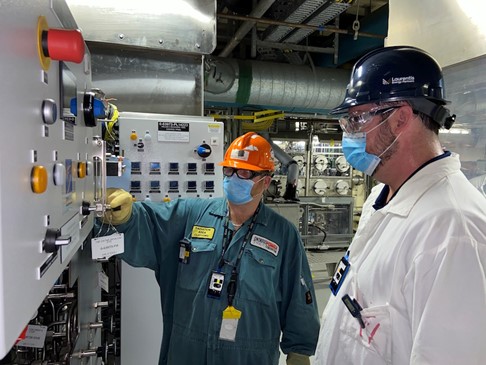Having completed three separate decommissioning projects, EnergySolutions takes the final steps in restoring the sites to a natural state.
For any nuclear power plant that has been permanently shut down, site restoration is the ultimate decommissioning goal when contracting with a utility to demolish a facility. The task, however, is not as simple as mobilizing heavy equipment and waving a wrecking ball or planting explosives to implode the facility, then loading up the debris and sending it to a landfill.
There is a real science and engineering approach necessary to safely restore the land to its original state. That has been the goal for EnergySolutions over the past decade as the company works to safely decommission shuttered nuclear power plants—packaging, transporting, and disposing of the waste, and restoring the sites for whatever reuse the owners and host communities see fit.
The headframe and buildings at the Gorleben salt dome in Germany. (Photo: Wikimedia Commons)
The German government has announced that it is closing the Gorleben salt mine in the Wendland region of Lower Saxony, officially removing the site from consideration as a repository for radioactive waste. Gorleben became a target of antinuclear protests after being proposed as a potential repository in the 1970s.
September 20, 2021, 12:04PMNuclear Newsthe Standards Committee An artist’s rendering of the NuScale plant. (Image: NuScale)
For more than two decades, the American Nuclear Society’s Standards Committee has recognized the benefit of incorporating risk-informed and performance-based (RIPB) methodology into ANS standards to improve their effectiveness, efficiency, and transparency. In general, standards using RIPB methods with properly identified and structured objectives need less modification and can be expected to remain valid for much longer periods.
BWXT Canada’s Cambridge, Ontario, facility. (Photo: BWXT Canada)
NuScale Power announced earlier this week that manufacturing process development work on its small modular reactor—the NuScale Power Module—is advancing at BWXT Canada Ltd.’s Cambridge, Ontario, facility in preparation for module fabrication. NuScale said that this work is critical to the development of its SMR technology and is an example of the supply chain development opportunities for Canadian companies with the requisite power plant equipment expertise.
Rendition of the IMSR400 power plant in the configuration proposed for the Darlington site. (Image: Terrestrial Energy)
Terrestrial Energy has upgraded the design of its Integral Molten Salt Reactor (IMSR) nuclear power plant, the company announced on September 14. The proposed facility will now feature 390 MWe of generation capacity for grid supply from twin reactors and generators.
Illinois governor J.B. Pritzker appreciates applause at the signing event for the state's new energy bill.
In an hour-long ceremony held yesterday at Chicago’s Shedd Aquarium amid some fanfare (it included an appearance by lizards, a snake, and a penguin), Illinois Gov. J.B. Pritzker signed into law the Climate and Equitable Jobs Act (S.B. 2408). The bill is a sweeping overhaul of the state’s energy policies aimed at phasing out fossil-fuel power generation and placing Illinois on a path to become a 100 percent carbon-free energy producer by 2050.
Don Perrie (left), of OPG, and Michael Lefebvre, of Laurentis Energy Partners, examine the He-3 extraction tool installed at Darlington NPP
Laurentis Energy Partners, a subsidiary of Ontario Power Generation (OPG), has launched a new program to produce helium-3. The He-3 will be obtained from tritium stored at OPG’s Darlington nuclear power plant, a four-unit CANDU station located about 100 kilometers east of Toronto.
Darlington houses one of the world’s largest reserves of tritium, which is a by-product of the heavy water used in CANDU reactors.
U.S. energy secretary Jennifer Granholm and India’s minister of petroleum and natural gas Hardeep Singh Puri remotely meet (with others in the background) during the virtual launch of a "newly revitalized” U.S.-India clean energy partnership.
U.S. energy secretary Jennifer Granholm and India’s minister of petroleum and natural gas, Hardeep Singh Puri, last week presided over the virtual launch of what the Department of Energy termed the “newly revitalized” U.S.-India Strategic Clean Energy Partnership (SCEP).
An archive photo of the Nevada National Security Site’s Test Cell C complex, which is being prepared for demolition and closure. (Photo: DOE)
The Department of Energy is preparing to demolish two large, complex facilities at the Nevada Nuclear Security Site with ties to historical nuclear propulsion rocket development and testing programs. The DOE’s Environmental Management (EM) Nevada Program and its environmental program services contractor, Navarro Research and Engineering, have begun characterization and hazard reduction work on the site’s Engine Maintenance, Assembly, and Disassembly (EMAD) and Test Cell C (TCC) complexes.




 The International Atomic Energy Agency has revised upward its projections regarding the potential growth of nuclear power’s capacity for electricity generation over the next three decades. The upward revision is the first by the IAEA since the Fukushima Daiichi accident in 2011.
The International Atomic Energy Agency has revised upward its projections regarding the potential growth of nuclear power’s capacity for electricity generation over the next three decades. The upward revision is the first by the IAEA since the Fukushima Daiichi accident in 2011.





. of OPG, and Michael Lefebvre, of Laurentis Energy Partners, examine tew He-3 extraction tool installed at Darlington NPP.jpg)




